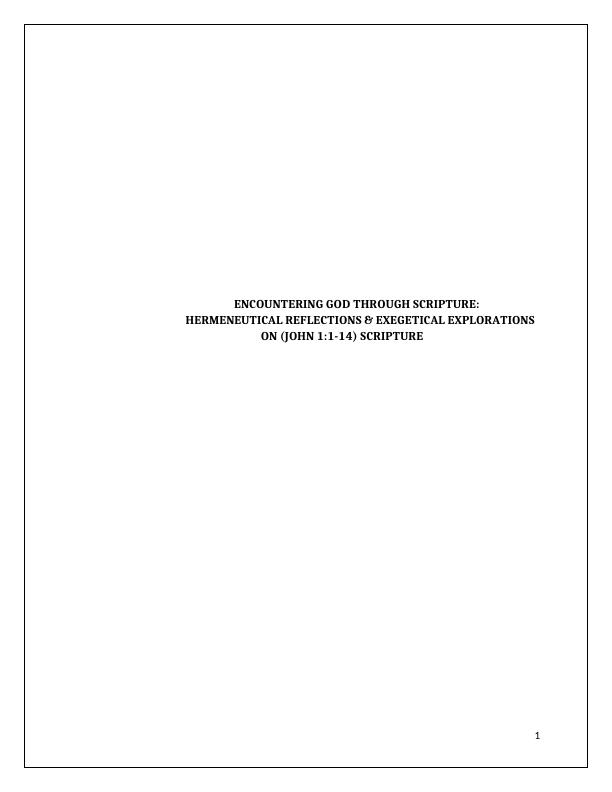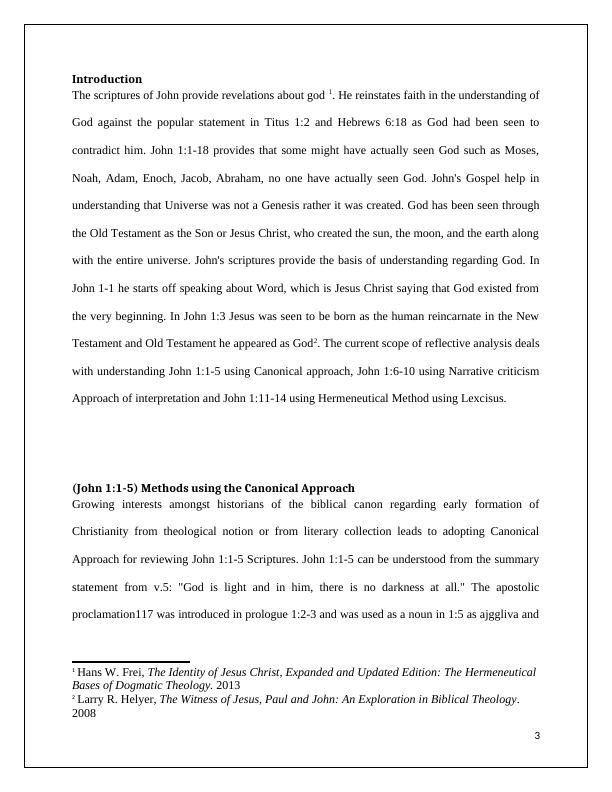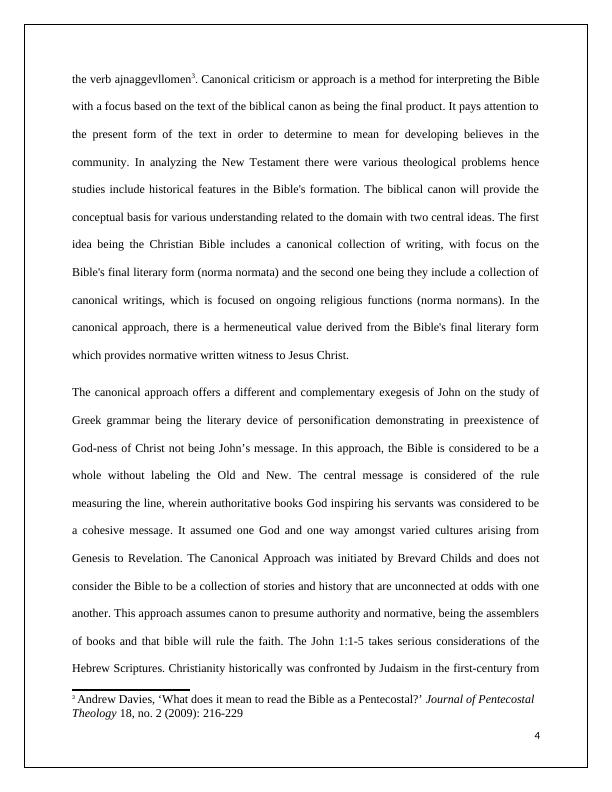Encountering God Through Scripture: Hermeneutical Reflections & Exegetical Explorations on John 1:1-14
Added on 2023-05-31
20 Pages6171 Words142 Views
ENCOUNTERING GOD THROUGH SCRIPTURE:
HERMENEUTICAL REFLECTIONS & EXEGETICAL EXPLORATIONS
ON (JOHN 1:1-14) SCRIPTURE
1
HERMENEUTICAL REFLECTIONS & EXEGETICAL EXPLORATIONS
ON (JOHN 1:1-14) SCRIPTURE
1

Table of Contents
Introduction......................................................................................................................................3
(John 1:1-5) Methods using Canonical Approach...........................................................................3
(John 1:6-10) Narrative Criticism Approach...................................................................................7
(John 1:11-14) Hermeneutical Method using Lexcisus method....................................................11
Conclusion.....................................................................................................................................16
BIBLIOGRAPHY..........................................................................................................................18
2
Introduction......................................................................................................................................3
(John 1:1-5) Methods using Canonical Approach...........................................................................3
(John 1:6-10) Narrative Criticism Approach...................................................................................7
(John 1:11-14) Hermeneutical Method using Lexcisus method....................................................11
Conclusion.....................................................................................................................................16
BIBLIOGRAPHY..........................................................................................................................18
2

Introduction
The scriptures of John provide revelations about god 1. He reinstates faith in the understanding of
God against the popular statement in Titus 1:2 and Hebrews 6:18 as God had been seen to
contradict him. John 1:1-18 provides that some might have actually seen God such as Moses,
Noah, Adam, Enoch, Jacob, Abraham, no one have actually seen God. John's Gospel help in
understanding that Universe was not a Genesis rather it was created. God has been seen through
the Old Testament as the Son or Jesus Christ, who created the sun, the moon, and the earth along
with the entire universe. John's scriptures provide the basis of understanding regarding God. In
John 1-1 he starts off speaking about Word, which is Jesus Christ saying that God existed from
the very beginning. In John 1:3 Jesus was seen to be born as the human reincarnate in the New
Testament and Old Testament he appeared as God2. The current scope of reflective analysis deals
with understanding John 1:1-5 using Canonical approach, John 1:6-10 using Narrative criticism
Approach of interpretation and John 1:11-14 using Hermeneutical Method using Lexcisus.
(John 1:1-5) Methods using the Canonical Approach
Growing interests amongst historians of the biblical canon regarding early formation of
Christianity from theological notion or from literary collection leads to adopting Canonical
Approach for reviewing John 1:1-5 Scriptures. John 1:1-5 can be understood from the summary
statement from v.5: "God is light and in him, there is no darkness at all." The apostolic
proclamation117 was introduced in prologue 1:2-3 and was used as a noun in 1:5 as ajggliva and
1 Hans W. Frei, The Identity of Jesus Christ, Expanded and Updated Edition: The Hermeneutical
Bases of Dogmatic Theology. 2013
2 Larry R. Helyer, The Witness of Jesus, Paul and John: An Exploration in Biblical Theology.
2008
3
The scriptures of John provide revelations about god 1. He reinstates faith in the understanding of
God against the popular statement in Titus 1:2 and Hebrews 6:18 as God had been seen to
contradict him. John 1:1-18 provides that some might have actually seen God such as Moses,
Noah, Adam, Enoch, Jacob, Abraham, no one have actually seen God. John's Gospel help in
understanding that Universe was not a Genesis rather it was created. God has been seen through
the Old Testament as the Son or Jesus Christ, who created the sun, the moon, and the earth along
with the entire universe. John's scriptures provide the basis of understanding regarding God. In
John 1-1 he starts off speaking about Word, which is Jesus Christ saying that God existed from
the very beginning. In John 1:3 Jesus was seen to be born as the human reincarnate in the New
Testament and Old Testament he appeared as God2. The current scope of reflective analysis deals
with understanding John 1:1-5 using Canonical approach, John 1:6-10 using Narrative criticism
Approach of interpretation and John 1:11-14 using Hermeneutical Method using Lexcisus.
(John 1:1-5) Methods using the Canonical Approach
Growing interests amongst historians of the biblical canon regarding early formation of
Christianity from theological notion or from literary collection leads to adopting Canonical
Approach for reviewing John 1:1-5 Scriptures. John 1:1-5 can be understood from the summary
statement from v.5: "God is light and in him, there is no darkness at all." The apostolic
proclamation117 was introduced in prologue 1:2-3 and was used as a noun in 1:5 as ajggliva and
1 Hans W. Frei, The Identity of Jesus Christ, Expanded and Updated Edition: The Hermeneutical
Bases of Dogmatic Theology. 2013
2 Larry R. Helyer, The Witness of Jesus, Paul and John: An Exploration in Biblical Theology.
2008
3

the verb ajnaggevllomen3. Canonical criticism or approach is a method for interpreting the Bible
with a focus based on the text of the biblical canon as being the final product. It pays attention to
the present form of the text in order to determine to mean for developing believes in the
community. In analyzing the New Testament there were various theological problems hence
studies include historical features in the Bible's formation. The biblical canon will provide the
conceptual basis for various understanding related to the domain with two central ideas. The first
idea being the Christian Bible includes a canonical collection of writing, with focus on the
Bible's final literary form (norma normata) and the second one being they include a collection of
canonical writings, which is focused on ongoing religious functions (norma normans). In the
canonical approach, there is a hermeneutical value derived from the Bible's final literary form
which provides normative written witness to Jesus Christ.
The canonical approach offers a different and complementary exegesis of John on the study of
Greek grammar being the literary device of personification demonstrating in preexistence of
God-ness of Christ not being John’s message. In this approach, the Bible is considered to be a
whole without labeling the Old and New. The central message is considered of the rule
measuring the line, wherein authoritative books God inspiring his servants was considered to be
a cohesive message. It assumed one God and one way amongst varied cultures arising from
Genesis to Revelation. The Canonical Approach was initiated by Brevard Childs and does not
consider the Bible to be a collection of stories and history that are unconnected at odds with one
another. This approach assumes canon to presume authority and normative, being the assemblers
of books and that bible will rule the faith. The John 1:1-5 takes serious considerations of the
Hebrew Scriptures. Christianity historically was confronted by Judaism in the first-century from
3 Andrew Davies, ‘What does it mean to read the Bible as a Pentecostal?’ Journal of Pentecostal
Theology 18, no. 2 (2009): 216-229
4
with a focus based on the text of the biblical canon as being the final product. It pays attention to
the present form of the text in order to determine to mean for developing believes in the
community. In analyzing the New Testament there were various theological problems hence
studies include historical features in the Bible's formation. The biblical canon will provide the
conceptual basis for various understanding related to the domain with two central ideas. The first
idea being the Christian Bible includes a canonical collection of writing, with focus on the
Bible's final literary form (norma normata) and the second one being they include a collection of
canonical writings, which is focused on ongoing religious functions (norma normans). In the
canonical approach, there is a hermeneutical value derived from the Bible's final literary form
which provides normative written witness to Jesus Christ.
The canonical approach offers a different and complementary exegesis of John on the study of
Greek grammar being the literary device of personification demonstrating in preexistence of
God-ness of Christ not being John’s message. In this approach, the Bible is considered to be a
whole without labeling the Old and New. The central message is considered of the rule
measuring the line, wherein authoritative books God inspiring his servants was considered to be
a cohesive message. It assumed one God and one way amongst varied cultures arising from
Genesis to Revelation. The Canonical Approach was initiated by Brevard Childs and does not
consider the Bible to be a collection of stories and history that are unconnected at odds with one
another. This approach assumes canon to presume authority and normative, being the assemblers
of books and that bible will rule the faith. The John 1:1-5 takes serious considerations of the
Hebrew Scriptures. Christianity historically was confronted by Judaism in the first-century from
3 Andrew Davies, ‘What does it mean to read the Bible as a Pentecostal?’ Journal of Pentecostal
Theology 18, no. 2 (2009): 216-229
4

End of preview
Want to access all the pages? Upload your documents or become a member.
Related Documents
Study on Christian Scripture and Hermeneuticslg...
|4
|805
|45
GOD AND SCRIPTURE.lg...
|19
|6535
|27
God and Scripturelg...
|19
|6802
|44
Theology Essay on Canonisation for Biblical Studieslg...
|8
|2619
|291
The Mission of God: Unlocking the Bible's Grand Narrativelg...
|5
|1223
|405
Kingdom of God: Theology, Ethics, and Paul's Epistleslg...
|5
|1068
|492
